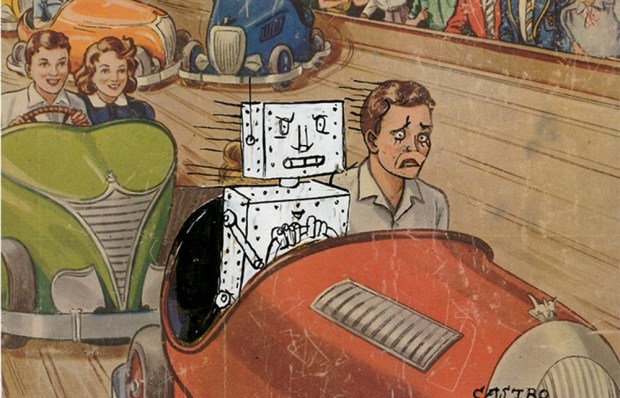I was waiting on an office forecourt recently puffing on an e-cigarette when a security guard came out. ‘You can’t smoke here,’ he shouted.
‘I’m not, actually,’ I replied.
He went to consult his superior. A few minutes later he reappeared.
‘You can’t use e-cigarettes here either.’
‘Why not?’
‘Because you are projecting the image of smoking.’
‘What, insouciance?’
‘Go away.’
I did.
This phrase ‘projecting the image of smoking’ — along with ‘renormalisation’, ‘gateway effect’ and the usual ‘think of the children’ — appears frequently in arguments for restricting the use of e-cigs in public places.
While new evidence may yet emerge to support restrictions, these reasons don’t convince me. Like the security guard’s response, they look like a desperate attempt to reverse-engineer a logical argument to suit an emotional predisposition.
As the psychologist Jonathan Haidt has shown, most moralising works this way. We react instinctively, and then hastily cast about for rationalisations. For instance, most Britons feel it is repulsive to eat dogs or even horses. If you ask why, they will contrive a whole series of fatuous arguments to defend what is really an emotional belief.
In the same way, people with a distaste for vaping eagerly seize on arguments like the gateway effect. This is the idea that non-smokers will take up e-cigarettes, and so migrate to real cigarettes. The gateway effect makes sense, too. Or it would, were it not that the evidence for it is somewhere between negligible and nonexistent. The traffic seems to flow entirely in the opposite direction — from smoking to vaping to (in many cases) quitting altogether. According to those fun-lovin’ guys at Ash, only 0.1 per cent of e-smokers have never smoked tobacco. Only 5 per cent of children use e-cigs more than once a week — almost all current or ex-smokers.
Frankly, I was surprised how low the figures were. I would have expected at least 5 per cent of nonsmokers to give e-cigs a try. What’s going on?
A possible explanation is that smoking is not so much an addiction as a habit: that after a few years of smoking, it is the associations, actions and mannerisms we crave more than the drug itself. Hence, if you have not first been addicted to smoking conventional cigarettes, e-cigs simply don’t hit the spot — just as those of us who have never been heroin addicts tend not to be all that keen on needles.
A few years ago, a high-court judge was driving home from his golf club after five or six double gin and tonics. He was pulled over by the police and breathalysed. When the machine barely registered an amber light, the police let him go — at which point he drove back to the club and demanded the head barman be fired for watering down the drinks.
It has been known for years by dodgy barmen that, after one proper G&T, you can sell people tonic water in a glass lightly rinsed in gin and they won’t notice the difference. And some more regular drinkers will still experience all the effects of drunkenness, even though they have consumed almost no alcohol. However, this works only if you have spent a lot of your past life drinking real G&Ts. Among heavy drinkers, the brain doesn’t wait for the booze to kick in — it shortcuts straight to the expected level of pissedness.
A similar placebo effect may mean that ersatz smoking only works for ex-smokers. If so, the good news for the vaping industry is that one common objection can be rejected. The ‘bad’ news is that e-cigarette sales may shrink as they run out of former smokers to convert.
Got something to add? Join the discussion and comment below.
Get 10 issues for just $10
Subscribe to The Spectator Australia today for the next 10 magazine issues, plus full online access, for just $10.
Rory Sutherland is vice-chairman of Ogilvy Group UK.
You might disagree with half of it, but you’ll enjoy reading all of it. Try your first month for free, then just $2 a week for the remainder of your first year.














Comments
Don't miss out
Join the conversation with other Spectator Australia readers. Subscribe to leave a comment.
SUBSCRIBEAlready a subscriber? Log in